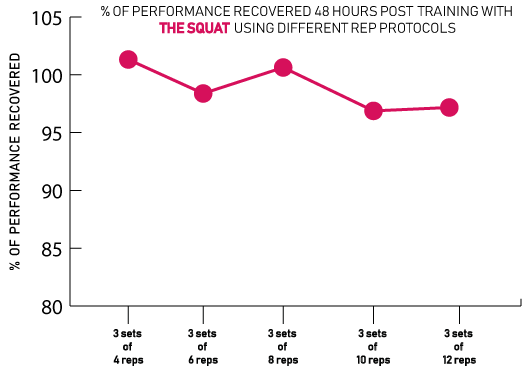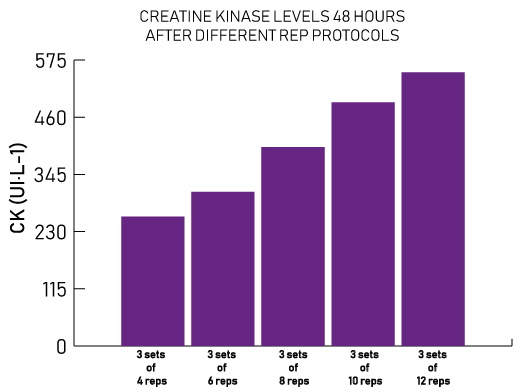Is the 6?12 rep range the only rep range that promotes muscle growth?
 (Image by author)
(Image by author)
When designing a muscle-building program, reps between 6?12 are commonly used with the belief this particular zone best promotes muscle growth.
This belief primarily originates from the traditional rep range continuum. This continuum states that 1?5 reps are ideal for strength, 6?12 reps are ideal for muscle growth, while 13+ reps are ideal for muscular endurance.
 Traditional rep range continuum (Image by author)
Traditional rep range continuum (Image by author)
This continuum does have some truth to it. More specifically, 1?5 reps are generally preferred for maximal strength development. Given strength is based on lifting the heaviest load, it makes perfect sense that training with a relatively heavy load (1?5 rep range) would optimize strength adaptations. There is evidence of this in the research.
Additionally, similar reasoning applies to the muscular endurance rep range. Given muscular endurance is based on the ability to sustain repeated contractions for an extended period, it?s logical that performing multiple reps (13+) would optimize this component. This too has support in the research.
However, when it comes to the muscle growth rep range, the traditional rep range continuum becomes slightly misleading.
The actual muscle growth rep range
The current experimental evidence does not support the notion hypertrophy is optimally achieved through performing 6?12 reps per set.
The best available evidence comparing various rep ranges for building muscle comes from a 2017 meta-analysis by Schoenfield et al.
For those unaware, meta-analyses combine the results of numerous individual scientific studies that address the same question. In general, meta-analyses are considered the most reliable form of scientific evidence for a given topic.
Returning to Schoenfield et al meta-analysis, they found that muscle growth was similar between high loads (~5?12 reps) and low loads (~12?40 reps) when reps were taken to failure.
In other words, the actual hypertrophy rep range seems to be much broader than the one proposed in the traditional continuum, similar hypertrophy is observed across the 5?40 rep range when reps are taken to, or close to, failure.
 Actual muscle growth rep range (Image by author)
Actual muscle growth rep range (Image by author)
One reason for this is likely because low reps (heavier weights) and high reps (lighter weights) stimulate a similar amount of muscle fibers when a set is taken in proximity to failure.
Let me explain:
Muscles contain motor units.
Each motor unit controls a certain number of muscle fibers.
Not all motor units are identical, characteristics of motor units range from slow and weak to fast and strong.
Generally, the slow motor units govern slower twitch muscle fibers, which have limited force-producing abilities.
The fast motor units govern faster twitch muscle fibers, which have greater force-producing abilities.
Motor units are recruited in a progressive sequence, termed Henneman?s size principle. First, slow motor units are recruited (also called low threshold motor units for this reason), as force requirements increase, fast motor units are recruited (also called high threshold motor units for this reason).
Regardless of the weight used, when reps are taken in proximity to failure, higher threshold motor units are recruited to sustain force production.
It?s likely lighter loads (such as 30% of an individuals 1RM) taken to failure, similarly recruit higher threshold motor units to heavier loads (such as 70% of an individuals 1RM) taken to failure.
Recruiting higher threshold motor units is essential to maximize hypertrophy as they typically possess greater growth potential compared to lower threshold motor units.
Application to training
We know the actual muscle growth rep range.
Applying this to training would mean an individual can self select the number of reps they wish to perform, given that it?s within the broad 5?40 rep range.
However, in some instances, the particular exercise being performed should be considered.
For example, with compound movements (exercises that train multiple muscles) such as the bench press, squat, and deadlift, maintaining correct form is necessary to not only minimize injury risk but to also efficiently train the desired muscles. Consequently, for beginners, it?s likely easier to focus on executing correct form with fewer repetitions, say 5?8 reps, as opposed to 20+ reps.
Conversely, isolation exercises, such as bicep curls and tricep pushdowns, do not have as much as a skill component to them compared to compound movements.
Hence, higher reps can easily be used with such movements.
Nonetheless, as an individual becomes more proficient at executing their compound movements, it?s viable to perform higher reps with them.
Ultimately, it?s best to select a rep range you enjoy. You?re more likely to put forth more effort into things you enjoy.
Therefore training will be more sustainable and effective.
Using a variety of rep ranges
As implied above, you may wish to train different movements with different rep ranges. However, it is also possible to train the same movement with different rep ranges across a weekly schedule.
For example, let?s say an individual performs the barbell bench press on Monday, Wednesday, and Friday. On Monday they may perform 3 sets of 5 reps, on Wednesday they may perform 3 sets of 10 reps, and on Friday they may perform 3 sets of 15 reps.
For some, this method may be far more enjoyable than training the same movement with the same rep range for weeks on end.
Interestingly, it?s feasible different rep ranges stimulate certain fiber types more than others. It?s speculated that higher reps may result in greater slow-twitch fiber hypertrophy, while lower reps may result in greater fast-twitch fiber hypertrophy. However, currently, the research analyzing this is contradictory. As a result, this notion has not successfully been verified or falsified as yet.
Nevertheless, implementing a variety of rep ranges for a single movement across a week does not appear to be detrimental.
This is illustrated by a 2016 paper by Schoenfield et al, who split 19 trained individuals into a constant rep group or a variety rep group.
Both groups trained the same seven exercises for 3 sets to failure, three times per week, for eight weeks.
The constant rep group trained all movements with 3 sets of 8?12 reps, while the variety rep group used 3 sets of 2?4 reps on day 1, 3 sets of 8?12 reps on day 2, and 3 sets of 20?30 reps on day 3.
Muscle thickness of the elbow flexors, triceps, and vastus lateralis (part of the quads) were measured before and after the training period.
After 8 weeks, there were no significant differences in muscle thickness increases between the two groups.
 (Image by author)
(Image by author)
In other words, both methods result in similar muscular adaptations.
Intriguingly, the varied rep range group did have a slight edge with regards to elbow flexor and tricep thickness. If this study was greater than 8 weeks, this difference may have become significant.
Rep ranges and fatigue
When sets are kept constant, different number of reps produce different amounts of fatigue and thus require different recovery periods.
A 2018 study by Pajera-Blanco et al examined the time course of recovery following training with 3 sets of 4 reps to failure, 3 sets of 6 reps to failure, 3 sets of 8 reps to failure, 3 sets of 10 reps to failure, and 3 sets of 12 reps to failure.
All of these protocols were carried out on the bench press and back squat.
Before participants performed either one of these rep schemes, a test to determine their V1 load on the bench press and back squat took place.
A V1 load is a weight that can be lifted at approximately 1 m.s-1 (1 meter per second).
The speed at which they could lift this load was then tested straight after, 6hrs after, 24hrs after, and 48hrs after they executed one of the protocols.
The speed at which a participant could lift their respective V1 load post-training was expressed as a percentage of performance recovered.
For instance, if a participant could lift their V1 load at a speed of 1 m.s-1 48hrs after training, this would equal a performance recovery of 100%.
The two graphs below detail the average performance recovered for participants 48hrs after completing each rep protocol on the bench press (top graph) and the squat (bottom graph).
 (Image by author)
(Image by author) (Image by author)
(Image by author)
Generally, for both the bench press and squat, higher reps failed to achieve full recovery 48hrs after training.
Put another way, when sets are constant, higher reps require longer recovery periods compared to lower reps.
This is especially true for 10 or more reps.
Pajera-Blanco et al also measured multiple biomarkers, one of which was creatine kinase, an enzyme used to assess muscle damage. Given the results above, it was unsurprising to see that higher reps resulted in greater elevations of this enzyme compared to lower reps.
 (Image by author)
(Image by author)
Thus, we can assume one reason higher reps require elongated recovery periods compared to lower reps, is due to the greater muscle damage provoked by higher reps.
Taking the aforementioned into consideration when planning a training program is important.
If residual fatigue is carried into the next session, performance will be impaired, subsequently, progressive overload cannot be achieved.
This will negatively impact long term adaptations. Although I will note some advanced athletes intentionally do this to functional overreach.
Notably, in the study above, all 3 sets were taken to failure.
Most commonly people maintain the same weight across all 3 sets with the last set usually achieving failure (or at least being in proximity to it). Because of this, I think it makes sense that recovery duration would be slightly less using this method as opposed to the method used in the study.
Nevertheless, it?s still clear that when sets are constant, higher reps do require longer recovery periods compared to lower reps.
If you were to perform a variety of rep ranges for a single movement across a week, understanding this idea will help make your training more productive.
For example, let?s say you train three times per week, on Monday, Wednesday, and Friday.
Since Friday and Monday are spaced out by 72 hours, It would be sensible to schedule your highest rep work on Friday, doing so would ensure sufficient recovery between the two sessions.
At the end of the day, I would recommend experimenting on yourself. The study above implies that it may be inappropriate to perform 3 sets of 12 reps to failure 3 times per week (given 2 training sessions are separated by 48hrs), though you may find this not to be the case for yourself.
Regardless of the number of reps you chose to perform, as long as performance is improving and progressive overload is applied, you?re all good to go.
Follow us on Instagram
Follow us on Twitter

